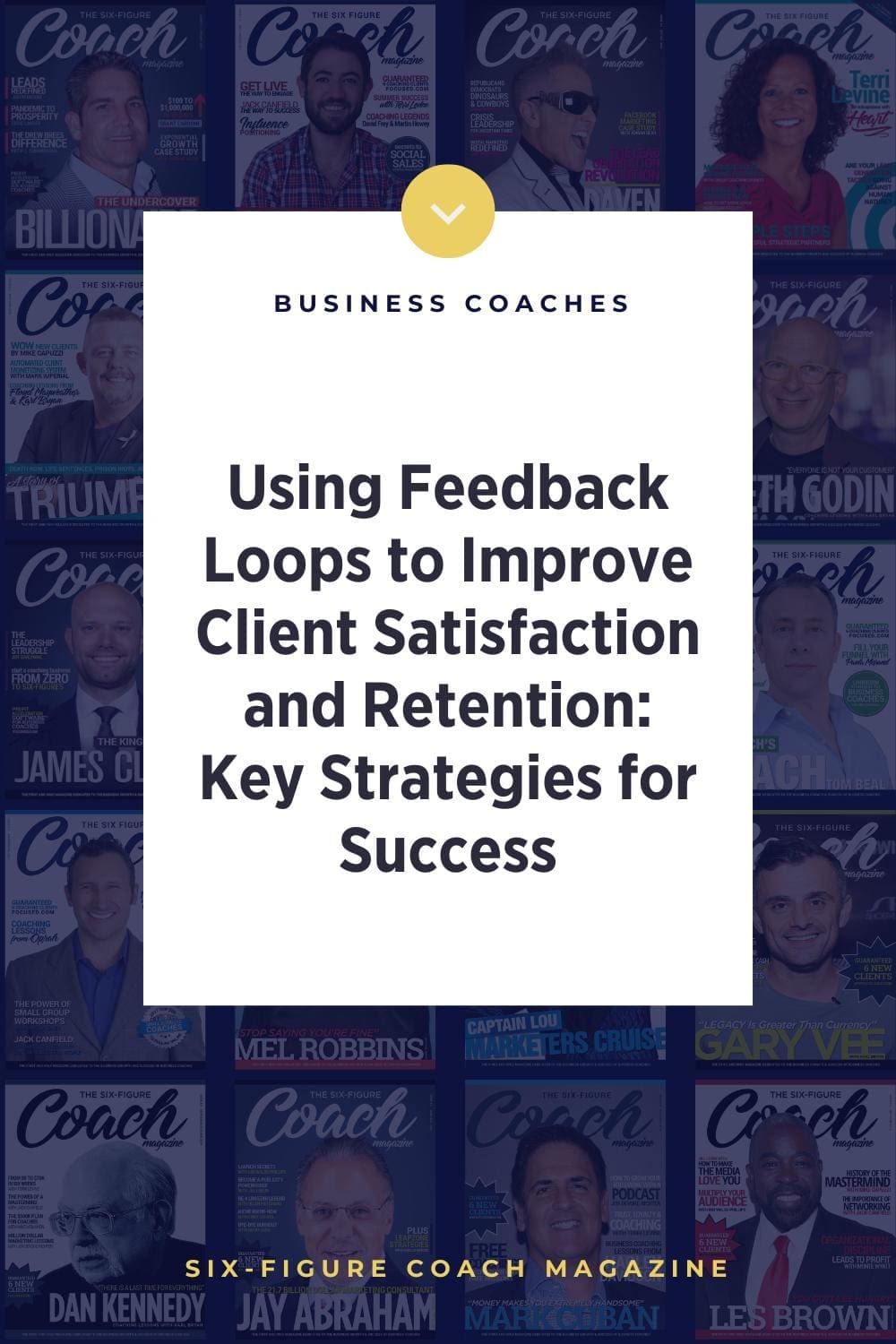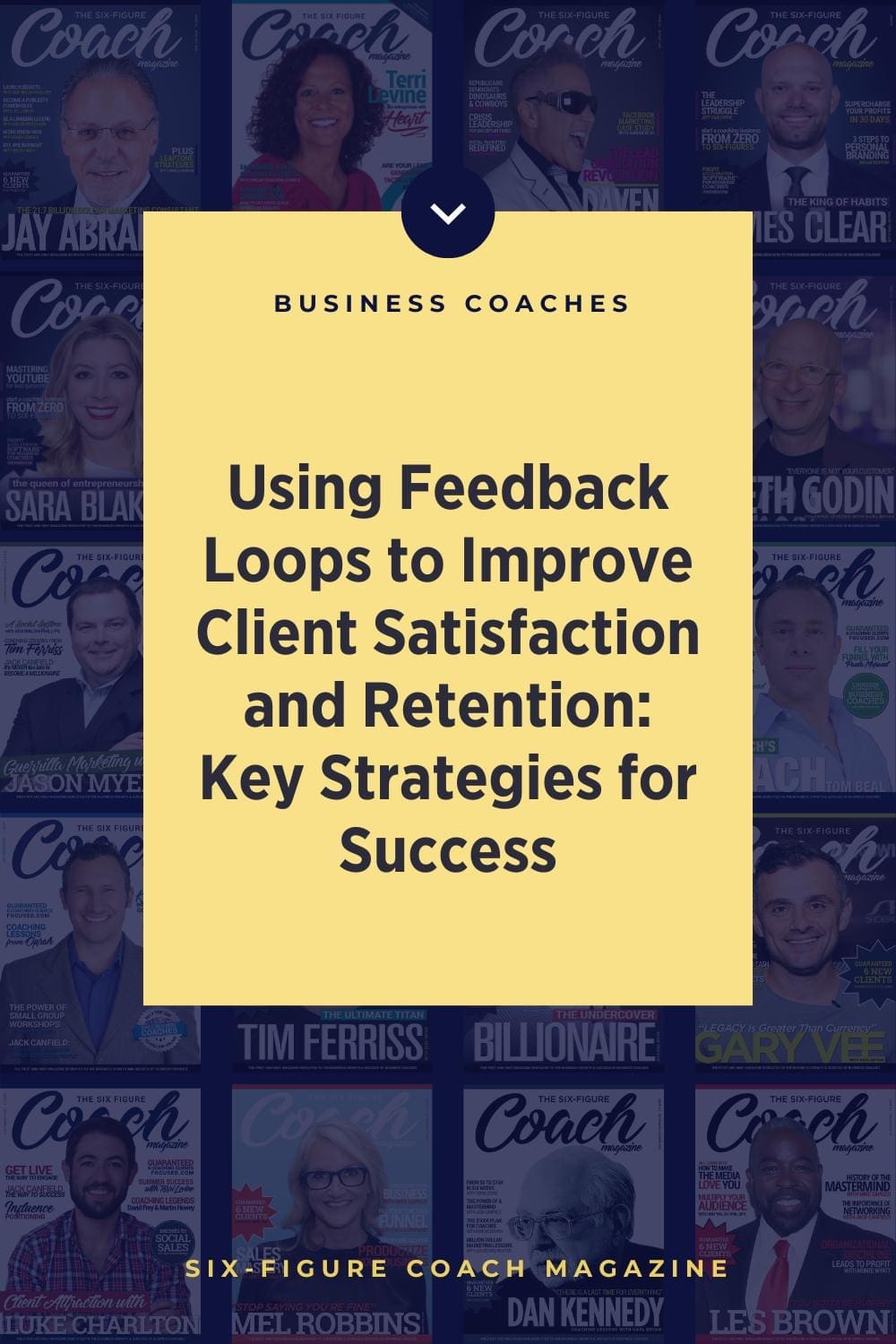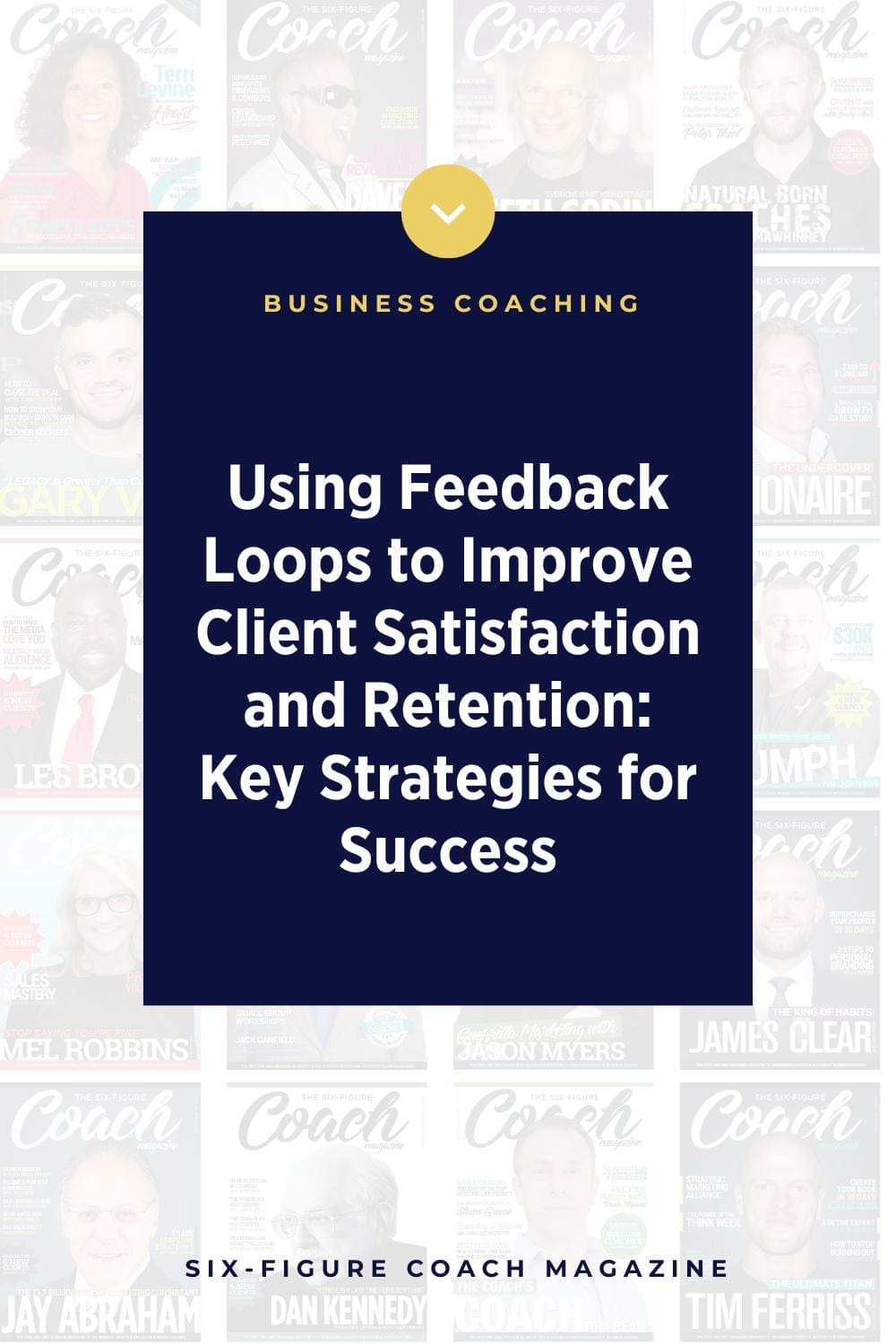Using Feedback Loops to Improve Client Satisfaction and Retention: Key Strategies for Success
In business, maintaining high client satisfaction and retention is crucial for long-term success. Feedback loops are essential tools in achieving this goal, enabling companies to continuously adapt to client needs and preferences. By systematically collecting and analyzing feedback, businesses can identify specific areas for improvement, thereby enhancing the overall client experience.
When effectively implemented, feedback loops foster a culture of transparency and build trust between clients and businesses. This ongoing exchange not only aids in refining products or services but also strengthens client relationships. Companies that prioritize feedback loops are more likely to see improved client satisfaction and loyalty, ultimately driving better business outcomes.
Clients appreciate when their opinions are valued and acted upon. Engaging them through feedback loops across various touchpoints ensures that their voices contribute to the company’s growth. This proactive approach leads to more personalized interactions, aligning business offerings with client expectations and laying a foundation for sustained engagement.
Understanding Customer Satisfaction and Retention
Customer satisfaction and retention are crucial for sustained business growth. Satisfaction often leads to loyalty, which in turn boosts retention, ultimately impacting a company’s market share. Analyzing these elements can provide insightful ways to enhance client relationships effectively.
Defining Key Terms
Customer satisfaction refers to the degree to which customers feel their needs and expectations have been met by a company’s products or services. It is typically measured through surveys and feedback mechanisms. Retention refers to a company’s ability to keep its customers over time. Maintaining a high retention rate often requires ongoing communication and consistent service quality.
Customer loyalty represents a long-term commitment from the customer, often resulting from high satisfaction and effective retention strategies. This loyalty can positively affect market share by reducing churn and increasing repeat purchases. Understanding these terms helps businesses tailor strategies to meet client expectations and foster enduring relationships.
The Importance of Customer Loyalty
Customer loyalty is vital for businesses aiming to achieve long-term success. It not only decreases acquisition costs but also increases the lifetime value of clients. Loyal customers are more likely to recommend a brand, indirectly increasing market share.
Loyalty also serves as a buffer in competitive markets, helping businesses maintain and even grow their share. By focusing on loyalty, companies can ensure steady revenue streams and build a positive reputation in the industry. This emphasis on long-term relationships is crucial for adapting to changing market dynamics.
Feedback Loops as a Tool for Engagement
Feedback loops are essential for fostering customer engagement. By efficiently capturing and analyzing customer interactions, businesses can craft tailored responses that enhance client satisfaction. This approach helps in identifying both strengths and weaknesses within service delivery, paving the way for actionable insights.
Elements of an Effective Feedback Loop
A well-designed feedback loop involves several key components. Collecting Data is the first step, where customer opinions are gathered through surveys, reviews, and direct interactions. Analysis follows, focusing on interpreting this data to extract actionable insights. Action is next, where companies address identified issues or capitalize on strengths. Monitoring ensures changes are impactful, maintaining a cycle that continuously improves.
Consistency is crucial. Feedback loops should be regular and structured to effectively track progress over time. Using technology, like analytics software, can streamline this process, enabling quicker responses and adaptation. Ultimately, an effective feedback loop should foster transparency and trust between a company and its clients, promoting a healthy, communicative relationship.
Positive vs Negative Feedback Loops
Positive feedback loops amplify the strengths by encouraging practices that customers appreciate. For instance, high ratings in customer service might lead to further investment in staff training. This type of loop focuses on replication and enhancement of successful strategies, driving increased satisfaction and loyalty.
Negative feedback loops highlight areas needing improvement. Negative comments or declining engagement signals require thorough investigation and strategic adjustments to address issues. This mechanism prevents stagnation by encouraging agility and problem-solving within an organization, ensuring ongoing improvement.
Both loops serve to enhance the customer experience when used effectively. Companies that maintain a balance between the two can address immediate concerns while reinforcing successful practices, contributing to a robust framework for long-term client retention and engagement.
Measuring Customer Feedback
Understanding how customers perceive a company’s services is vital for sustaining client satisfaction and improving retention. Employing structured methods like the Net Promoter Score (NPS) and other metrics such as Customer Effort Score (CES) and Customer Satisfaction Score (CSAT) can provide valuable insights.
Net Promoter Score (NPS) and Its Relevance
NPS is a metric that assesses a customer’s likelihood to recommend a business to others. Customers rate their likelihood on a scale from 0 to 10. Scores are categorized into three groups: Promoters (9-10), Passives (7-8), and Detractors (0-6). The NPS is calculated by subtracting the percentage of Detractors from the percentage of Promoters.
NPS offers a clear indicator of the overall customer sentiment and potential growth through word-of-mouth referrals. Companies use it to gauge loyalty and benchmark against competitors. This metric helps identify areas needing improvement, effectively hearing the voice of the customer and maintaining a competitive edge in the market.
Other Metrics: CES and CSAT
CES focuses on the ease of customer interaction and obtaining a product or service. Customers rate the effort required on a scale, helping businesses identify friction points. Lower effort typically corresponds with higher retention and satisfaction. This metric highlights operational areas that may need refinement to improve the customer experience.
CSAT measures customer satisfaction regarding specific interactions or experiences. It’s often based on a direct question related to satisfaction levels, with responses ranging from very unsatisfied to very satisfied. CSAT provides immediate feedback, allowing companies to act quickly on areas needing attention. Utilizing CSAT and CES alongside NPS offers a comprehensive view of customer feedback, driving engagement and loyalty.
Effective Communication Strategies
Effective communication is vital for enhancing client satisfaction and retention. Direct and indirect feedback along with leveraging multiple channels can significantly improve engagement. A strategic approach helps address concerns and adapt to client needs efficiently.
Leveraging Direct and Indirect Feedback
Using a combination of direct and indirect feedback methods can enhance communication. Direct feedback includes tools like customer interviews which provide firsthand insights into client experiences and expectations. Engaging clients in personal conversations helps gather specific and actionable insights.
Indirect feedback, such as data from online reviews, allows businesses to identify trends and patterns in customer opinions. Analyzing this feedback helps in recognizing broader issues affecting satisfaction. Businesses can then tailor strategies to improve areas highlighted by clients.
Incorporating both types of feedback ensures a comprehensive approach to understanding and addressing client needs. Structured analysis and regular monitoring of feedback empower companies to make informed decisions to improve client experiences.
Maximizing Engagement Through Multiple Channels
Engaging clients effectively requires utilizing a variety of communication channels. Email, social media, and direct messaging are essential tools to maintain consistent and personalized interactions. Offering multiple avenues for communication ensures clients can choose their preferred method.
Regular updates through these channels keep clients informed and engaged. Social media platforms particularly enable real-time interaction and foster a sense of community. Businesses benefit from providing prompt responses, building trust and loyalty.
Implementing an omnichannel approach improves accessibility, allowing for seamless integration of feedback and follow-up actions. This strategy ensures continuity in communication and enhances retention by catering to the diverse preferences of the client base.
Implementing Continuous Improvement
For continuous improvement in client satisfaction and retention, organizations must prioritize analyzing feedback and fostering an adaptive customer service environment. This approach ensures actionable insights are utilized to enhance processes while maintaining high levels of employee and client satisfaction.
Analyzing Feedback for Actionable Insights
A robust customer feedback system is pivotal. It gathers and organizes feedback into categories such as product quality, service efficiency, and employee interactions. Identifying trends within this data helps in pinpointing areas requiring improvement.
By transforming feedback into actionable insights, leaders can formulate effective strategies. Setting specific goals based on customer suggestions or concerns enhances satisfaction. Regularly scheduled reviews of these insights ensure that strategies remain relevant and impactful.
Visual tools like dashboards offer real-time visibility into customer sentiments, facilitating timely decisions. Engaging employees by sharing insights fosters a culture of transparency and inclusion, boosting employee happiness and agency in addressing customer needs.
Cultivating an Adaptive Customer Service Environment
Creating an atmosphere where continuous adaptation is the norm requires commitment from leadership. Employees benefit from ongoing training and resource accessibility, which helps them respond adeptly to evolving client demands. This adaptability empowers frontline workers to make informed decisions without undue delay.
Encouraging a mindset of flexibility among the team enhances their ability to cater to diverse client expectations. Recognizing and rewarding proactive behavior supports employee satisfaction and motivation.
Regular team meetings provide a platform for discussing customer feedback, enabling the workforce to continually refine their approach. By fostering open communication, organizations create an environment where employees can thrive and contribute meaningfully to client satisfaction.
Conclusion
Feedback loops play a crucial role in improving client satisfaction and retention. By continuously gathering and analyzing customer feedback, businesses can adapt and refine their services to meet evolving needs. This promotes a culture of responsiveness and shows clients they are valued.
Implementing structured feedback mechanisms, like surveys and regular check-ins, allows organizations to track client sentiment effectively. Using data from these interactions helps identify trends and areas for improvement. Prioritizing feedback assists in addressing issues before they escalate, which enhances trust and loyalty.
Ensuring transparent communication with clients when acting on their feedback underscores commitment to their satisfaction. Being open about the steps taken demonstrates accountability and builds long-term relationships. Client trust elevates when they see tangible results from their input.
Analyzing feedback not only resolves existing challenges but also reveals opportunities for innovation. It guides businesses to develop new solutions that resonate with their audience. Harnessing this insight encourages continuous growth and positions companies as forward-thinking.
Organizations that leverage feedback effectively foster a sense of collaboration with their clients. Engaging clients in the solution process empowers them and deepens the connection. Collaborative relationships are more likely to achieve sustained satisfaction and retention.
The impact of feedback loops extends beyond immediate problem-solving. They form an integral part of strategic planning and decision-making. Companies that integrate this feedback into their strategies remain agile and better equipped to navigate market changes.
Incorporating feedback loops as a regular business practice informs and strengthens client-centric approaches. It is a proactive measure that ensures services align with client expectations. Prioritizing this approach sets a foundation for a thriving, client-oriented business model.
You may also like
Many Paths to Success: The Tools and Systems That Power Top Business Coaches
Explore the many tools, programs, and paths business coaches use to succeed — and see why Focused.com’s Profit Acceleration Software™ is the ultimate system for growth and client results.
The Three Unbreakable Pillars of Business Coaching Success
Discover the three unstoppable strategies every business coach needs—lead generation, conversion, and fulfillment—to build a powerhouse coaching practice. Book a call to learn more.
The Power of Cloning: Why Reinventing the Wheel is Killing Your Coaching Business
Discover why cloning proven business models and strategies is the ultimate shortcut to growing your coaching business, and how you can take action today.












